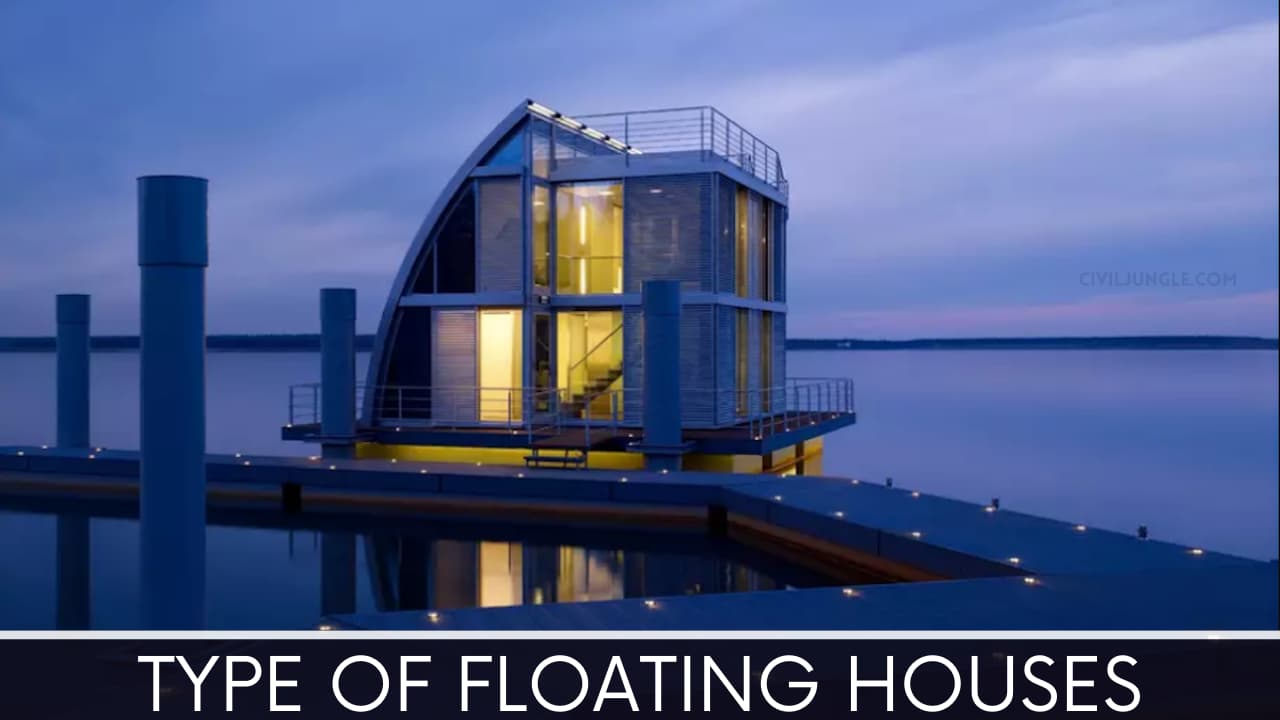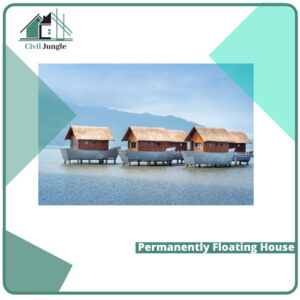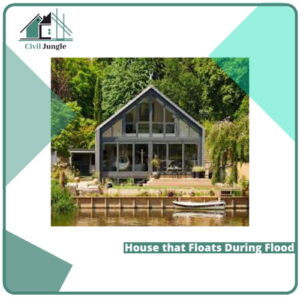
What Are Floating Houses?

Floating house is generally a modern type of technology which is very popular in recent times. In today’s world, there are lack of free space to build a house or any type of structure because all the accessible free places are almost covered up.
To recover this problem, you need to think those problem in different ways. As the result, engineers have found an unique solution for this problem, which is floating houses. Floating houses are constructed on the wooden deck, all the other units of houses are installed after deck is placed.
Floating houses are permanently connected with electrical wirings, plumbing lines, sewer lines, etc. The weight of concrete is too heavy that’s why to reduce the weight of the whole structure engineers includes wooden particle or plywood particle for constructing the whole structure.
What Is Floating Building?
Floating house is type of house which is constructed over a floating system which allows floating the whole structure over the water. Floating building is permanent structure which is fixed at one place and you can not navigate this from one place to another.
This type of building can not move and it is tied up with another permanent structure. Floating building is environmental friendly structure because it does not create disturbance to the sea bed or the sore of the sea and all the wastes are perfectly placed to their destination.
The cost of floating building is little bit expensive because the higher range of raw materials and the technique is also modern so it requires higher technology machineries which cost is high. Also it requires skilled labour and labour charge is more and all over the total system is very new in our civilization, so the demand of this system is very low. That is the another reason of higher price range of this type of building structure.
Related Article
- Type of Arch
- Floating Slab Vs Monolithic
- All About Floating Floor | What Is a Floating Floor | Advantages And Disadvantages of Floating Floor | Types of Floating Floor
- What Is Floating Slab| Floating Slab Construction | How to Build a Floating Slab | Advantages & Disadvantages Floating Slabs
- What is Floating Foundation | Suitability of the Floating Foundation | Advantages & Disadvantage of Floating Foundation | How to Build a Floating House Foundation
Floating Architecture Examples
There are so many floating architectures are constructed all over the world. In all over the world there are eight milestone floating architectures are present, those are in the following-
- Drijvend Paviljoen (Floating Pavilion): This architecture is located in the Rotterdam Nieuwe river, Netherland. This architecture is constructed by Public Domain Architecten and DeltaSync. It is made of beams which is made of steel and transparent ETFE films are used to access light in the daytime as well as at night time.
- The Exbury Egg: This is one kind of laboratory, home and workplace which Is located in the river of Beaulieu in Hampshire, England. This structure is made of cedar woods and fiberglass.
- Wa Sauna: This is the architecture which is located at the middle of the lake. This is located in Seattle’s Lake Union.
- Floating Lake Cabin: It is located at the middle of the lake and created by MOS architecture. It is generally a guest house which is made of cedar woods. It is directly accessed at the second level of the house and by modern technology, tidal impacts are resisted.
- Drie Streken: It is the floating structure which is located in the Northern Netherland and everyone comes here for feeling the beauty pf sunrise and sunset.
- Floating Island: Floating Island is located in Lake Zurich, Switzerland. It is designed by Studio Tom Emerson and 30 students. There is a swimming pool inside the island and you can also watch movies because there is also a cinema hall.
- Archipelago Cinema: This is the movie hall which is located at Kudu island, Thailand. It is one of the best movie hall in all over the world. Ole Scheeren designed the whole structure of the building.
Type of Floating Houses

There are generally two types of floating houses, those are in the following-
1. Permanently Floating House

It is a type of house which floats permanently on the water surface. It is a modern technique and it requires extra construction cost.
2. House that Floats During Flood

Those houses which floats during flood time and when water goes out then it will on ground. This type of house is mainly found in Kerala.
Those buildings are made of steel and the side walls are made of wood materials. Here we use steel pistons to avoid the flow of the whole building. In the time of flood the whole structure will go upward.
Example of a Floating House
Here, the Example of a floating house are as follows.
- The floating house is a very unique and modern house. Stepping Stone House is one of the best examples of a floating house.
- Actually, the floating house is not floating, it is actually resting on the water.
- Stepping stones are used to access the water body which is around the floating floor.
- A floating house is the best and dream house for water lovers.
Principle of a Floating House
Here, the principle of a floating house are as follows.
- The main principle of floating house is to float the whole house.
- It is done by applying four steel tube support by which it can move upward or downward, it is applicable for those floating house which floats during flood time.
- The principle of other type floating house is it’s floating all time over the water surface which is applicable for permanently floating house.
Floating Houses
A floating building is a building unit with a flotation system at its base, to allow it to float on water. It is common to define such a building as being “permanently moored” and not usable in navigation. Floating buildings are usually towed into location by another ship and are unable to move under their own power.
How Do Floating Houses Work?
Think of a floating home like a condo, but rather than a unit in a building, it’s a unit on the water with HOA dues paid to maintain the dock and slip. Floating homes are permanently connected to sewer, water and electrical, built and moved into place just once.
Types of Floating Houses
- Permanently-floating homes in lakes and other waterways.
- Homes that float only when flood waters swell, but sit on the ground during the dry season.
Advantages of Floating Houses
One of the biggest advantages to buying a floating home should be obvious: unlike houseboats, they don’t need a motor or method of self-propulsion. You can build upwards or outwards without affecting the cruising ability, since all it needs to do is float.
Disadvantages of Floating Houses
There is a cost to everything and living on the water is no different. Real estate openings on the water can be quite scarce, and there is less inventory for these types of homes and fewer options for you to choose from. Floating homes are known for racking up quite the monthly bill.
How to Build a Floating House Foundation?
A floating foundation is a type of foundation constructed by excavating the soil in such a way that the weight of structure built on the soil is nearly equal to the total weight of the soil excavated from the ground including the weight water in the soil before the construction of structure.
What Is a Float House?
Think of a floating home like a condo, but rather than a unit in a building, it’s a unit on the water with HOA dues paid to maintain the dock and slip. Floating homes are permanently connected to sewer, water and electrical, built and moved into place just once.
Are Floating Homes a Good Investment
While floating homes can appreciate in value, they can take longer to sell. It’s a unique home and not every buyer is looking for alternative living. Since floating homes are usually cheaper than traditional homes on land, they can be a good investment for some buyers.
Floating Foundation Example
A poured cement slab without footing creates a floating foundation. When constructing out-buildings such as sheds, the term can take on another meaning. Some flooring systems for outside sheds are known as floating foundation floors and do not require any concrete to be poured.
Floating Foundation Cost
Raft foundations cost from $5 to $10 per square foot. The cost to build a 1,350-square-foot raft foundation is an average of $10,125. Reinforcing the concrete with rebar costs an additional $1 to $2 per square foot.
Floating Home Pros and Cons
The benefits of these homes are that they offer a unique type of housing that many people don’t have access to. They also come in various styles, so there is something for everyone. The downside is that most floating homes require more upkeep than other types of homes.
How to Build a Floating House?
All floating homes now are built with concrete floats. In one, the concrete works as a giant floatation device with Styrofoam inside it, where the Styrofoam is floating and the concrete is forming an upside-down bowl over the Styrofoam.
Like this post? Share it with your friends!
Suggested Read –
- How to Reduce Construction Cost (Tips)
- 10 Different Types of Kitchen Sinks | Kitchen Sinks
- All About Transom Window | What Is a Transom Window | Types of Transom Window
- What Is Drip Irrigation | Drip Irrigation Advantages | Types of Irrigation | Drip Irrigation System
- All About Door Hinges | 13 Different Types of Door Hinges | What Is Door Hinges | Types of Door Hinges

